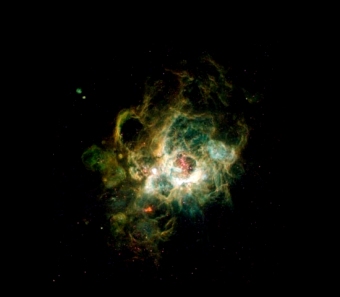
A stellar nursery is a nebula in which stars are being
formed. Enterprise NX-01 charted a stellar nursery in 2151. (ENT: "Cold
Front")
A stellar nursery is an interstellar molecular cloud
whose density and size permits th formation of molecules, most commonly
molecular hydrogen (H2), and eventually stars. Two distinct types, of
molecular cloud are known, both associated with star formation: giant
molecular clouds (GMCs) and dwarf molecular clouds.
A GMC is huge complex of interstellar gas and dust,
composed mostly of molecular hydrogen but also containing many other
types of interstellar molecule. GMCs are the coolest (10 to 20 K) and
densest (106 to 1010 particles/cm3) portions of the interstellar
medium. Stretching typically over 150 light-years and containing
several hundred thousand solar masses of material, they are the largest
gravitationally bound objects in the Galaxy and, in fact, the largest
known objects in the universe made of molecular material.
Dwarf molecular clouds or Bok Gobules are much smaller
and denser than GMCs but may still be the scene of star formation. They
contain molecular hydrogen (H2), carbon oxides and helium, and around
1% (by mass) of silicate dust. Bok globules most commonly result in the
formation of double or multiple star systems
|
